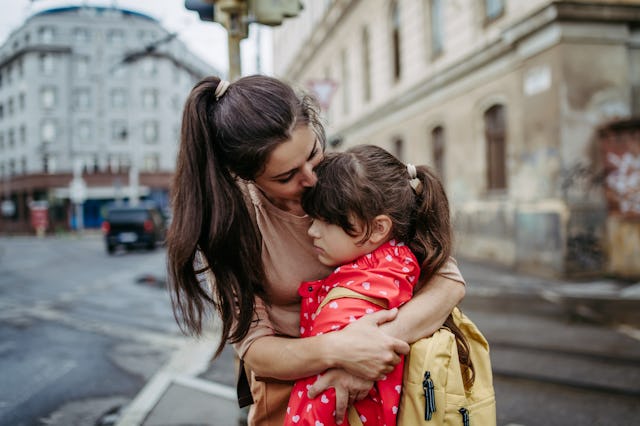What I Want You To Know About Non-Verbal Learning Disability
It wasn’t always easy, but we’ve figured it out — together.

When my daughter was barely three, I spied her shoving our cat from her place at the kitchen table. Frustrated, Eva exclaimed, “Syd — get lost, get found, get anywhere, just get out of my chair!”
Eva’s verbal gifts were extraordinary. Neatness and order were not her forte, but she did well in school, and was engaging, cheerful, and kind.
But as Eva entered 7th grade in fall 2004, her notebooks became messier. She lost assignments, misplaced books, struggled in math and Latin. I assumed puberty and sports were responsible and was sure a bit of tutoring and my coaching would help.
I was wrong.
By December of 9th grade, Eva was failing algebra. She’d misplaced textbooks so often, I bought two sets, one for school and one for home. Frustrated teachers called about disruptive behavior; only her advisor genuinely wanted to help. Eva reacted to routine stressors with escalating anger; she had trouble sleeping and was depressed. I nagged about schoolwork and tried to manage her assignments. She was so different from the sparkling child she had been that I feared the onset of a serious medical issue.
One evening, as I launched another homework harangue, Eva interrupted: “Mom, something’s wrong with me. I need help.” She didn’t need to repeat herself. I sprang into action.
A clinical psychologist’s assessment indicated Eva’s verbal proficiency scores were above the 90th percentile, but non-verbal skills were below average, several in teens and single digits. Functioning at a 55% level, Eva had a non-verbal learning disability (NVLD) profile, with deficiencies present in autism spectrum disorder.
As it turns out, Eva showed all the classic signs: difficulties with quantitative reasoning (she was failing Algebra I); poor spatial perception (she couldn’t read maps, understand graphs, or build jigsaw puzzles); lack of fine motor dexterity (gripping a pencil, scissors, buttons, and table utensils were all difficult; she couldn’t tie her shoes); and impaired executive functions (she struggled with planning, organization, and multitasking).
Stunned but relieved, Eva and I at last understood how seemingly disparate difficulties — like reading maps, managing schedules, even using utensils — were connected. Her teachers were “blown away” by the psychologist’s report.
Sessions with a pediatric neuropsychologist provided more insight: Eva had managed elementary arithmetic by memorizing operations tables, thinking everyone did, without understanding them. Her disruptive classroom behavior stemmed from frustration about falling behind.
NVLD is hard to diagnose. Verbally talented children mask deficiencies early on, and young children reach basic milestones at different times, while still developing normally. Earnest NVLD research began only after 1970, while research on verbal disorders, including dyslexia, began a century earlier. Recent research estimates close to 3 million children up to age 18 have NVLD, but it may be higher because many children go undiagnosed.
Inevitably, NVLD children “hit a wall” as young teens. Eva couldn’t memorize her way through higher level math; her ease with English didn’t help her conjugate French verbs. More assignments, competing priorities, changing classes all derailed her deficient executive functions. But once she hit the wall, she was ready to bounce back. I just had to adjust my expectations of what helping her looked like. (As her doctor told me: “Stop obsessing over everything, let others help, and allow Eva to figure out some coping strategies.”)
After years of struggle — and hard-wrought successes — Eva graduated from high school and then college six years later. There wasn’t a simple set-it-and-forget-it magical fix. Together we’ve had to restructure how we face situations and adjust our expectations as we go. She got into her top choice college, only to realize she needed a closer school so she could live at home. When Eva was accepted to a graduate program at Carnegie Mellon, five hours away from all she’d known, I realized she needed help to make the move happen — and so I did the legwork to find her an apartment.
And that’s what I want others to understand. NVLD can be a lifelong struggle. Together, Eva and I have compiled our lessons learned — so far:
- Comparative “issues” at young ages matter, and teachers need more training. Eva’s pre-school teacher for three years cautioned me because Eva’s verbal skills were far above age, but her art skills were far below (“not at all representational”). She was the only teacher until Eva’s diagnosis in 9th grade to spot a potential problem. I wish her other teachers had had the context necessary to help her earlier.
- Social and behavioral dimensions of NVLD can undermine progress. There are accommodations for academic issues, and training regimens for physical limitations. We learned the hard way, though, that environmental changes often cause paralyzing anxiety for NVLD sufferers. Once we realized that, we could work on it — but I wish we’d understood it sooner.
- Help from people outside the immediate family can be extremely beneficial. The best thing I did for Eva was to back off and hire an awesome tutor. Together, she and Eva developed coping skills, set evolving goals, and prepped for classes.
Lastly, remember that family members (especially high achieving ones) can create enormous pressure. Even when they don’t intend it. Stop expecting, start imagining, and don’t lose hope!
Clorisa Phillips is a historian and essayist, retired from a career in higher education. She explores family stories, aiming to reveal overlooked or commonly unknown facets of life. Her personal essays have appeared in The Christian Science Monitor, The Atlanta Journal-Constitution, and The New York Times. She lives in Charlottesville, Virginia.
This article was originally published on